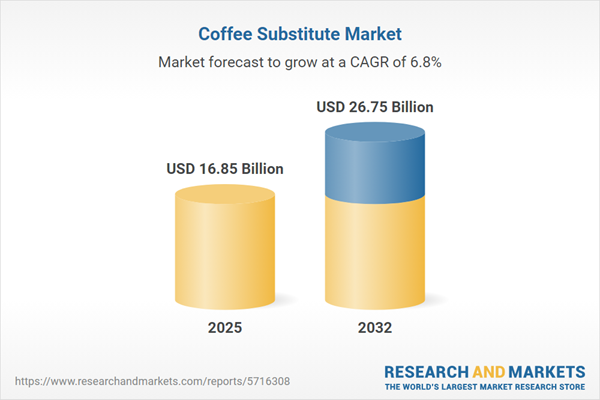Speak directly to the analyst to clarify any post sales queries you may have.
The global coffee substitute market is entering a phase of transformative change, presenting senior decision-makers with both obstacles and opportunities in consumer wellness, sustainability strategy, and operational agility. As the market landscape evolves, decisive action is essential to secure future competitiveness and meet heightened stakeholder expectations.
Market Snapshot: Coffee Substitute Market Growth Outlook
The coffee substitute market is on a sustained upward trajectory, expanding from USD 15.76 billion in 2024 to USD 16.85 billion in 2025, with projections reaching USD 26.75 billion by 2032 and a CAGR of 6.84%.
Growth momentum is supported by rising demand for functional beverages and the increasing appeal of wellness-oriented options. Companies actively diversify portfolios, prioritize health attributes, and speed up product innovation to capture share in an expanding, competitive space. These factors are driving strategic investment and evolution throughout the sector.Scope & Segmentation
This research provides a tailored segmentation structure supporting high-precision market engagement for senior executives. Each segment helps inform investment, supply chain, and go-to-market strategies in a rapidly diversifying sector.
- Product Types: Barley, carob, chicory, dandelion, herbal blends, and malt are each positioned to meet diverse consumer needs—including caffeine-free preferences and demand for beverages with enhanced wellness benefits.
- Distribution Channels: Food service, convenience stores, hypermarkets, supermarkets, direct-to-consumer models, third-party marketplaces, and specialty retail offer broad market coverage and adaptability to evolving buyer preferences.
- Form Factors: Granules, instant powder, liquid concentrate, roasted, and ground forms enable brands to tailor offerings for operational convenience and distinct user applications.
- End Users: Commercial and household markets are both addressed, spanning hospitality, catering, retail, institutional, and domestic consumption scenarios.
- Packaging Formats: Bulk bags, cans, sachets, and single-serve pods reflect a range of priorities, from cost-efficiency to on-the-go convenience and sustainability in packaging choices.
- Price Ranges: Economy, mid-tier, and premium price points enable targeted regional positioning, capturing customer segments with varied purchasing power.
- Ingredient Types: Single-ingredient recipes and blended formulas support trends toward clean-label products and customizable health or flavor attributes.
- Regions: Coverage includes the Americas, Europe, Middle East & Africa, and Asia-Pacific, allowing assessment of distinctive consumer behaviors, regulatory requirements, and commercial opportunities.
- Technologies: Advanced processing, ingredient extraction, blockchain, QR traceability, and sustainable packaging approaches are highlighted as core enablers of operational transparency and efficiency.
Coffee Substitute Market: Key Takeaways
- Market value is increasingly shaped by demand for beverages that align with wellness and reduced-caffeine trends, prompting portfolio realignment and new product strategies.
- Transparent supply chains and digital traceability tools are now crucial for regulatory compliance and reinforcing buyer confidence across both institutional and consumer markets.
- Detailed segmentation strategies by product and customer group drive sharper market targeting and open potential in mainstream and specialized beverage niches.
- Brands leveraging digital consumer outreach and influencer partnerships can respond rapidly to evolving consumption behaviors and address emerging micro-segments effectively.
- Sustainability, particularly in packaging and process design, now drives both operational improvements and competitive differentiation in discerning markets.
- Collaborative strategies between ingredient suppliers and horeca channels are expanding market access and supporting customized offerings that address growing commercial demand.
Tariff Impact: Navigating US Trade Policies
The recent tariff changes in the United States, effective from 2025, are altering sourcing and input costs for coffee substitute product manufacturers. Ingredients such as barley and carob must now comply with new import terms, driving companies to restructure supplier partnerships and manage costs more rigorously. Organizations are mitigating risks by sourcing from alternative suppliers, adjusting product lines, and refining distribution processes to protect operational continuity and market access.
Methodology & Data Sources
This analysis follows a mixed-methods approach, integrating in-depth interviews, industry-wide surveys, and critical review of authoritative data. Validation tools such as SWOT and PESTEL analysis ensure the reliability and strategic value of findings.
Why This Report Matters
- Delivers in-depth segmentation and clear insight into the latest technologies and supply chain intelligence, giving decision-makers confidence in market evaluation and planning.
- Clarifies operational and regulatory risks from new tariffs, enabling agile strategic responses to input cost and compliance dynamics.
- Supports targeted go-to-market execution and tailored regional strategies by offering nuanced analysis of shifting consumer preferences and competitive developments within the coffee substitute market.
Conclusion
This report provides leadership teams with strategic, evidence-based analysis to anticipate market changes, refine their competitive stance, and unlock sustainable growth opportunities within the evolving coffee substitute sector.
Additional Product Information:
- Purchase of this report includes 1 year online access with quarterly updates.
- This report can be updated on request. Please contact our Customer Experience team using the Ask a Question widget on our website.
Table of Contents
3. Executive Summary
4. Market Overview
7. Cumulative Impact of Artificial Intelligence 2025
List of Figures
Samples

LOADING...
Companies Mentioned
The key companies profiled in this Coffee Substitute market report include:- Nestlé S.A.
- Kraft Heinz Company
- The Roasted Grain Company, Inc.
- Barleycup International Limited
- Dandy Blend Limited
- Inka Food Sp. z o.o.
- Post Consumer Brands, LLC
Table Information
| Report Attribute | Details |
|---|---|
| No. of Pages | 196 |
| Published | October 2025 |
| Forecast Period | 2025 - 2032 |
| Estimated Market Value ( USD | $ 16.85 Billion |
| Forecasted Market Value ( USD | $ 26.75 Billion |
| Compound Annual Growth Rate | 6.8% |
| Regions Covered | Global |
| No. of Companies Mentioned | 8 |









